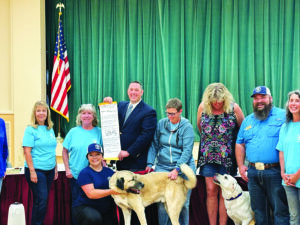
by Nathan Boddy
Hamilton City Council had a busy schedule at its regular meeting on Tuesday, August 20. The meeting began with a brief presentation from the Bitterroot Humane Association, which outlined some of its community outreach programs, before asking Mayor Dominic Farrenkopf to declare “Dogust” the unofficial birthday month of all shelter dogs. Dogust is a widely recognized program designed to raise awareness of shelter animals and recognizes that the birth dates of shelter animals are often difficult or impossible to determine.

Following the reports from staff and the mayor, the council received a brief presentation of the Preliminary Architectural Report (PAR) developed to outline options for the city’s old city hall. Crystal Herzog and Paul Filicetti of A&E Design gave the presentation, which highlighted the process the city followed to determine the best and most desirable use for the building. The building itself was most recently used as the city’s fire station until the newly constructed fire station at the corner of Foxfield and Skeels opened late last year.
The historic building at 175 South 3rd opened in 1906 and served the city as a fire station, library, and city hall. The library moved to the Carnegie Building (its current location) in 1916, and the city offices moved to the Bedford Building in 1990.
In 2020, however, the fire station proved to be undersized for modern firefighting equipment and crews. Fire Chief Brad Mohn told the Bitterroot Star at the time that the building had “served its purpose,” but that costly modifications to both the building and equipment were needed to continue operations at the site. These difficulties, along with the ever-increasing emergency needs of a growing Hamilton, led to the new fire station and the abandonment of 175 South 3rd. The vacating of the building has consequently opened up opportunities for new use. The PAR is the first step in identifying those opportunities.
A&E stated that they conducted an architectural review of existing conditions and a site assessment. Through their efforts, a steering committee was able to narrow the possible alternatives down to three potential options. Each of the three possible outcomes took into account not only the future use of the historic building, but also the current location of the city’s City Hall and the adjacent Bitterroot Public Library. Ultimately, through outreach and analysis, the scope was narrowed down to a preferred alternative for the site.
Planning Director Matthew Rohrbach explained to council members that the city used funds from the Montana Department of Environmental Quality’s Brownfields Program to pay for the PAR. He also told council that the presentation of the PAR was for informational purposes only and no decision was being asked of them at this time.
As explained in the presentation, the preferred alternative for the site is to co-locate City Hall and the library. This alternative, which received nearly half of the votes from citizen participation, would return the building to City Hall, while also providing an extension to the existing library and connecting the two buildings. The development would involve removing the garage parking spaces, excavating a basement, and clearing the alley between the buildings. The newly constructed connection between City Hall and the library would allow for improved access through a new staircase and elevator to the higher floors, as well as expanded public space.
The PAR argues that the co-location alternative offers several benefits, including keeping the historic building under city ownership and rebuilding the city’s original City Hall. The option could also result in more foot traffic near downtown businesses while allowing the city to consider other uses for City Hall’s current location at 223 South 3rd Street. Regarding the Bitterroot Public Library, the PAR notes, “Library expansion space is not currently planned but provides a target square footage as recommended in the Bitterroot Public Library’s May 2023 Community and Facilities Needs Assessment Final Report.”
After A&E’s presentation, councilors asked a number of questions about PAR. Of course, the estimated cost of the overall project was a concern. PAR estimates that the total cost of rebuilding the historic building and expanding the library over a vacated alley would be over $20 million. For this reason, Rohrbach reiterated the need to move slowly.
“It’s a big project and it has a big price tag,” he said. “We didn’t want to come tonight with the assumption that a decision could be made.” Rohrbach said he understood that a project of this size and cost could take many years and involve many steps. The PAR, he said, represents a first step and is an opportunity for the council to open discussions.
Later in the meeting, the council heard a presentation from city finance manager Craig Shepherd and ultimately adopted the fiscal year 2025 budget. Shepherd thanked the mayor and council for all their work in supporting the city and for helping put together the budget, which he said was balanced and where “total needs match total resources.”

